1998 VOLVO V90 brakes
[x] Cancel search: brakesPage 63 of 175

1998 Volvo S90
Volvo allows the use of the
following "oxygenated fuels";
however, the octane ratings
listed on this page must still be
met. of fuel. Therefore, it is
advisable to refuel as soon as
possible when the needle nears
the red zone, or when the fuel
warning light comes on.
Driving economy pg. 56
Economical driving
conserves natural
resources
Better driving economy may be
obtained by thinking ahead,
avoiding rapid starts and stops
and adjusting the speed of your
vehicle to immediate traffic
conditions. Observe the
following rules:
l Bring the engine to normal
operating temperature as soon
as possible by driving with a
light foot on the accelerator
pedal for the first few minutes
of operation. A cold engine
uses more fuel and is subject to
increased wear.
l Whenever possible, avoid
using the car for driving short
distances. This does not allow
the engine to reach normal
operating temperature.
l Drive carefully and avoid
rapid acceleration and hard
braking.
l Do not exceed speed limit.
l Avoid carrying unnecessary
items (extra load) in the car.
l Check tire pressure regularly
l Remove snow tires when
threat of snow or ice has ended.
l Note that roof racks, ski
racks, etc., increase air
resistance and thereby fuel
consumption.
l Avoid using automatic
transmission kick-down feature
unless necessary.
l Avoid using the air
conditioning when it is not
required. When engaged, the
air conditioner's compressor
places places an additional load
on the engine. However, please
note that fuel consumption is
lower with the air conditioning
on than it is when driving with
the air conditioning switched
off and the windows down.
Other factors which decrease
gas mileage are:
l Worn or dirty spark plugs
l Incorrect spark plug gap
l Dirty air cleaner
l Dirty engine oil and clogged
oil filter
l Dragging brakes
l Incorrect front end alignment
Some of the above mentioned
file:///K|/ownersdocs/1998/1998_SV90/98S90_053.htm (4 of 6)12/30/2006 \
1:52:41 PM
Page 77 of 175
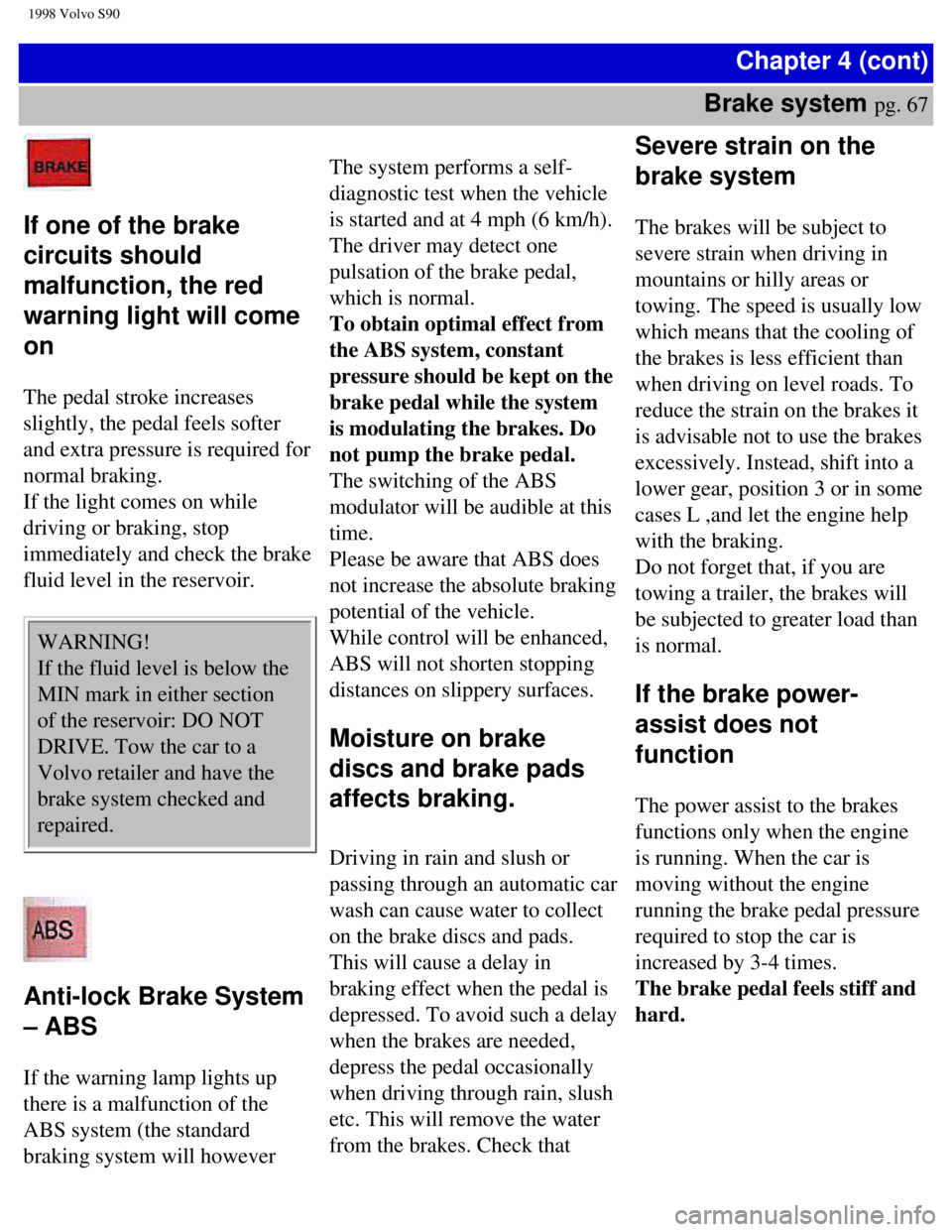
1998 Volvo S90
Chapter 4 (cont)
Brake system
pg. 67
If one of the brake
circuits should
malfunction, the red
warning light will come
on
The pedal stroke increases
slightly, the pedal feels softer
and extra pressure is required for
normal braking.
If the light comes on while
driving or braking, stop
immediately and check the brake
fluid level in the reservoir.
WARNING!
If the fluid level is below the
MIN mark in either section
of the reservoir: DO NOT
DRIVE. Tow the car to a
Volvo retailer and have the
brake system checked and
repaired.
Anti-lock Brake System
– ABS
If the warning lamp lights up
there is a malfunction of the
ABS system (the standard
braking system will however
The system performs a self-
diagnostic test when the vehicle
is started and at 4 mph (6 km/h).
The driver may detect one
pulsation of the brake pedal,
which is normal.
To obtain optimal effect from
the ABS system, constant
pressure should be kept on the
brake pedal while the system
is modulating the brakes. Do
not pump the brake pedal.
The switching of the ABS
modulator will be audible at this
time.
Please be aware that ABS does
not increase the absolute braking
potential of the vehicle.
While control will be enhanced,
ABS will not shorten stopping
distances on slippery surfaces.
Moisture on brake
discs and brake pads
affects braking.
Driving in rain and slush or
passing through an automatic car
wash can cause water to collect
on the brake discs and pads.
This will cause a delay in
braking effect when the pedal is
depressed. To avoid such a delay
when the brakes are needed,
depress the pedal occasionally
when driving through rain, slush
etc. This will remove the water
from the brakes. Check that
Severe strain on the
brake system
The brakes will be subject to
severe strain when driving in
mountains or hilly areas or
towing. The speed is usually low
which means that the cooling of
the brakes is less efficient than
when driving on level roads. To
reduce the strain on the brakes it
is advisable not to use the brakes
excessively. Instead, shift into a
lower gear, position 3 or in some
cases L ,and let the engine help
with the braking.
Do not forget that, if you are
towing a trailer, the brakes will
be subjected to greater load than
is normal.
If the brake power-
assist does not
function
The power assist to the brakes
functions only when the engine
is running. When the car is
moving without the engine
running the brake pedal pressure
required to stop the car is
increased by 3-4 times.
The brake pedal feels stiff and
hard.
file:///K|/ownersdocs/1998/1998_SV90/98S90_067.htm (1 of 5)12/30/2006 \
1:52:43 PM
Page 78 of 175
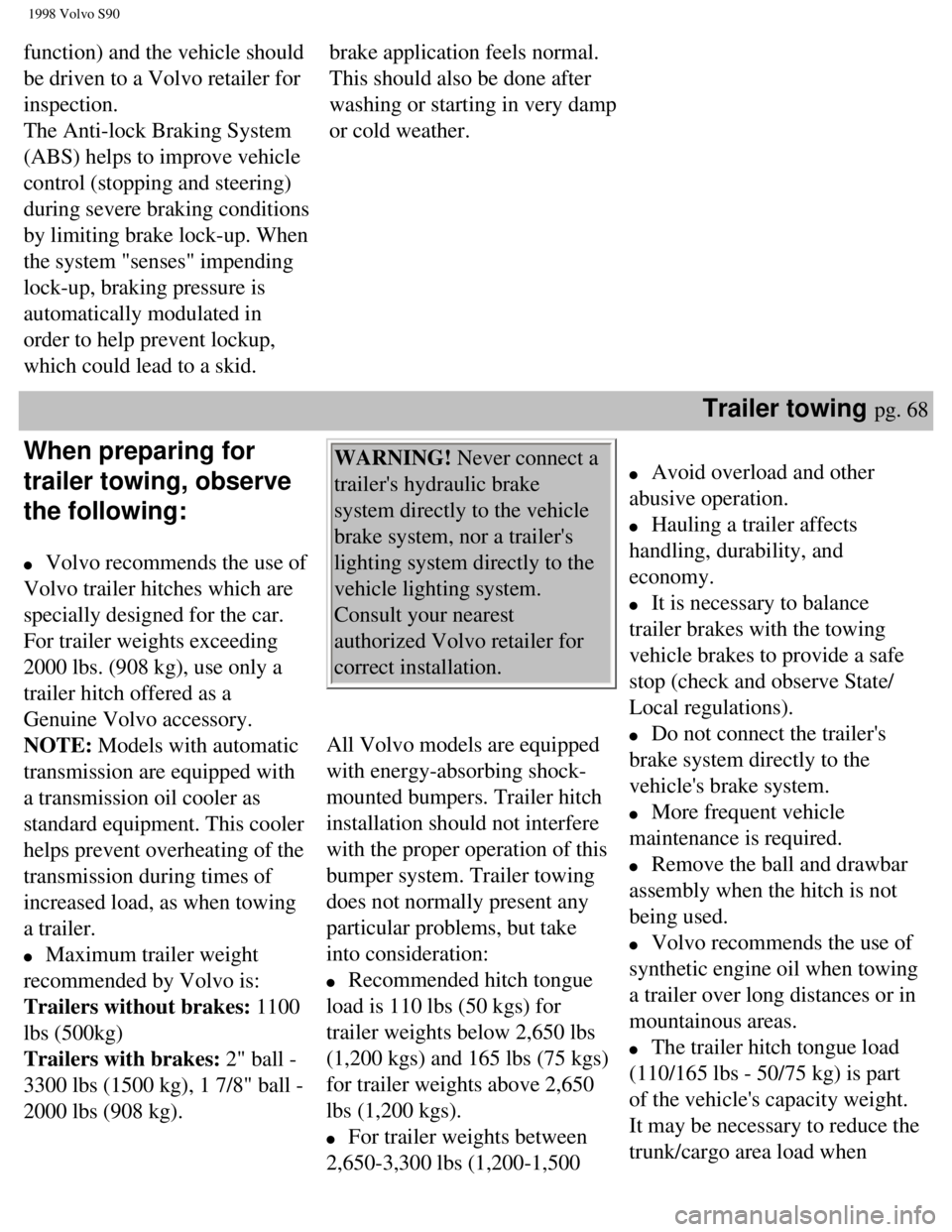
1998 Volvo S90
function) and the vehicle should
be driven to a Volvo retailer for
inspection.
The Anti-lock Braking System
(ABS) helps to improve vehicle
control (stopping and steering)
during severe braking conditions
by limiting brake lock-up. When
the system "senses" impending
lock-up, braking pressure is
automatically modulated in
order to help prevent lockup,
which could lead to a skid. brake application feels normal.
This should also be done after
washing or starting in very damp
or cold weather.
Trailer towing pg. 68
When preparing for
trailer towing, observe
the following:
l Volvo recommends the use of
Volvo trailer hitches which are
specially designed for the car.
For trailer weights exceeding
2000 lbs. (908 kg), use only a
trailer hitch offered as a
Genuine Volvo accessory.
NOTE: Models with automatic
transmission are equipped with
a transmission oil cooler as
standard equipment. This cooler
helps prevent overheating of the
transmission during times of
increased load, as when towing
a trailer.
l Maximum trailer weight
recommended by Volvo is:
Trailers without brakes: 1100
lbs (500kg)
Trailers with brakes: 2" ball -
3300 lbs (1500 kg), 1 7/8" ball -
2000 lbs (908 kg).
WARNING! Never connect a
trailer's hydraulic brake
system directly to the vehicle
brake system, nor a trailer's
lighting system directly to the
vehicle lighting system.
Consult your nearest
authorized Volvo retailer for
correct installation.
All Volvo models are equipped
with energy-absorbing shock-
mounted bumpers. Trailer hitch
installation should not interfere
with the proper operation of this
bumper system. Trailer towing
does not normally present any
particular problems, but take
into consideration:
l Recommended hitch tongue
load is 110 lbs (50 kgs) for
trailer weights below 2,650 lbs
(1,200 kgs) and 165 lbs (75 kgs)
for trailer weights above 2,650
lbs (1,200 kgs).
l For trailer weights between
2,650-3,300 lbs (1,200-1,500
l Avoid overload and other
abusive operation.
l Hauling a trailer affects
handling, durability, and
economy.
l It is necessary to balance
trailer brakes with the towing
vehicle brakes to provide a safe
stop (check and observe State/
Local regulations).
l Do not connect the trailer's
brake system directly to the
vehicle's brake system.
l More frequent vehicle
maintenance is required.
l Remove the ball and drawbar
assembly when the hitch is not
being used.
l Volvo recommends the use of
synthetic engine oil when towing
a trailer over long distances or in
mountainous areas.
l The trailer hitch tongue load
(110/165 lbs - 50/75 kg) is part
of the vehicle's capacity weight.
It may be necessary to reduce the
trunk/cargo area load when
file:///K|/ownersdocs/1998/1998_SV90/98S90_067.htm (2 of 5)12/30/2006 \
1:52:43 PM
Page 80 of 175

1998 Volvo S90
cold-weather oil for hard driving or in warm
weather. See section "Engine oil" for more
information.
l The load placed on the battery is greater during
the winter since the heater, windshield wipers,
lighting etc. are used more often. Moreover, the
capacity of the battery decreases as the
temperature drops. In very cold weather, a poorly
charged battery can freeze and be damaged. It is
therefore advisable to check the state of charge
more frequently and spray an anti-rust oil on the
battery posts.
l Volvo recommends the use of snow tires on all
four wheels for winter driving - see section
"Wheels and tires".
l To prevent the washer reservoir from freezing,
add washer solvents containing antifreeze. This is
important since dirt is often splashed on the
windshield during winter driving, thus requiring
frequent use of the washers and wipers.
functions when the transmission is in reverse.
Also see "Winter/Wet" mode on page 59.
Winter/Wet mode
Enhanced Vehicle Traction
This mode may be selected for starting/moving
off on slippery roads or to lower downshift speeds
if the transmission is in "L".
Mode W
*In position D, the gearbox starts in third gear and
changes up to fourth gear.
*In position 3, second gear is locked and there is
no change up to third gear. In position L, first gear
is locked.
*These positions always offer the kick-down
feature.
Long distance trip pg. 70
Before a long distance trip
It is always worthwhile to have your car checked at a Volvo retailer
before driving long distances. Your retailer will also be able to supply\
you with bulbs, fuses, spark plugs and wiper blades for your use in the \
event that problems occur.
If you prefer to check the car yourself, please note the following:
l Check that the engine runs smoothly and that fuel consumption is
normal.
l Check engine oil, coolant levels, and for possible fuel leakage.
l Check transmission oil level and rear axle for leakage.
l Check condition of drive belts.
l Check state of charge of battery.
l Examine tires carefully (the spare tire as well), and replace those
that are worn. Check tire pressures.
l The brakes, front wheel alignment, and steering gear should be
checked by your Volvo retailer only.
l Check all lights, including high beams.
file:///K|/ownersdocs/1998/1998_SV90/98S90_067.htm (4 of 5)12/30/2006 \
1:52:43 PM
Page 83 of 175

1998 Volvo S90
When replacing tires, be sure that the new tires
are the same size designation, type (radial) and
preferably from the same manufacturer, on all
four wheels. Otherwise there is a risk of altering
the car's road-holding and handling
characteristics.
NOTE:When storing wheel/tire assemblies (e.g.
winter tires and wheels), either stand the
assemblies upright or suspend them off the
ground. Laying wheel/tire assemblies on their
sides for prolonged periods can cause wheel and/
or tire damage.
Wear indicator
The tires have a so-called "wear indicator" in the
form of a number of narrow strips running across
or parallel to the tread. When approx. 1/16" (1.6
mm) is left on the tread, these strips show up and
indicate that the tire should be replaced.
Tires with less than 1/16" (1.6 mm) tread have a
very poor grip in rain or snow.
All tires become warm during use. After cooling,
when the vehicle is parked, the tires have a
tendency to distort slightly, forming flat spots.
These flat spots can cause vibrations similar to the
vibrations caused by imbalanced wheels.
They do, however, disappear when the tire warms
up. The degree to which the flat spots form
depends on the type of cord used in the tire.
Remember that, in cold weather, it takes longer
for the tire to warm up and consequently longer
for the flat spot to disappear.
Wheels and tires (cont.) pg. 73
Snow chains
Snow tire chains can be used on your Volvo with
the following restrictions:
l Snow chains should be installed on rear wheels
only. Use only Volvo approved snow chains.
l Snow chains can only be used on tires which
are not wider than 195 mm.
l Sufficient clearances between chains and
brakes, suspension and body components must be
maintained.
l Some strap-on type chains will interfere with
brake components and therefore CANNOT be
used.
Consult your Volvo retailer for additional snow
Snow tires, studded tires*
Tires for winter use:
Owners who live in or regularly commute
through areas with sustained periods of snow
or icy driving conditions are strongly advised
to fit suitable winter tires to help retain the
highest degree of traction.
It is important to install winter tires on all four
wheels to help retain traction during cornering,
braking and accelerating. Failure to do so could
reduce traction to an unsafe level or adversely
affect handling. Do not mix tires of different
design as this could also negatively affect overall
tire road grip.
file:///K|/ownersdocs/1998/1998_SV90/98S90_071.htm (2 of 5)12/30/2006 \
1:52:44 PM
Page 117 of 175
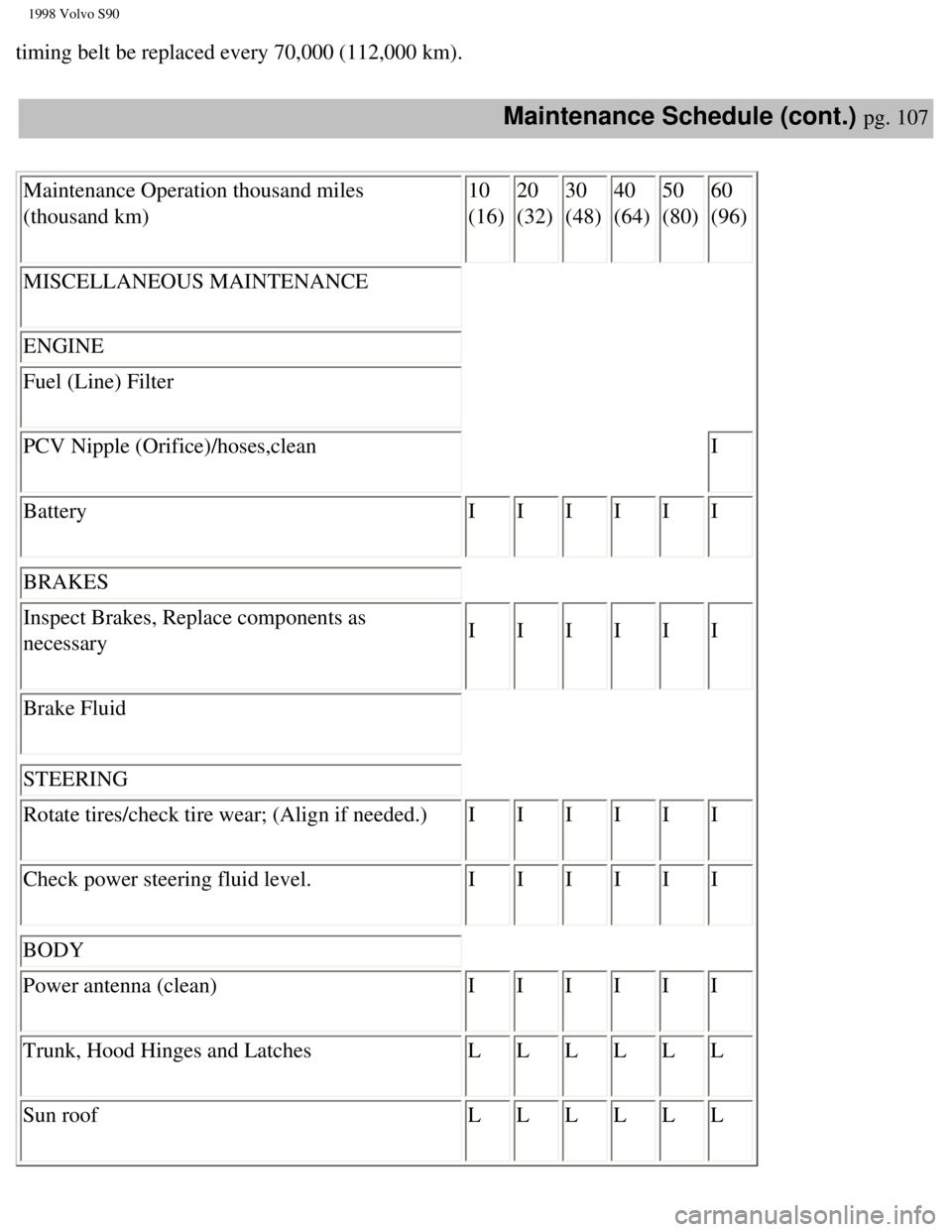
1998 Volvo S90
timing belt be replaced every 70,000 (112,000 km).
Maintenance Schedule (cont.) pg. 107
Maintenance Operation thousand miles
(thousand km) 10
(16) 20
(32) 30
(48) 40
(64) 50
(80) 60
(96)
MISCELLANEOUS MAINTENANCE
ENGINE
Fuel (Line) Filter
PCV Nipple (Orifice)/hoses,clean I
Battery I I I I I I
BRAKES
Inspect Brakes, Replace components as
necessary I
I I I I I
Brake Fluid
STEERING
Rotate tires/check tire wear; (Align if needed.) I I I I I I
Check power steering fluid level. I I I I I I
BODY
Power antenna (clean) I I I I I I
Trunk, Hood Hinges and Latches L L L L L L
Sun roof L L L L L L
file:///K|/ownersdocs/1998/1998_SV90/98S90_103.htm (6 of 7)12/30/2006 \
1:52:48 PM
Page 138 of 175
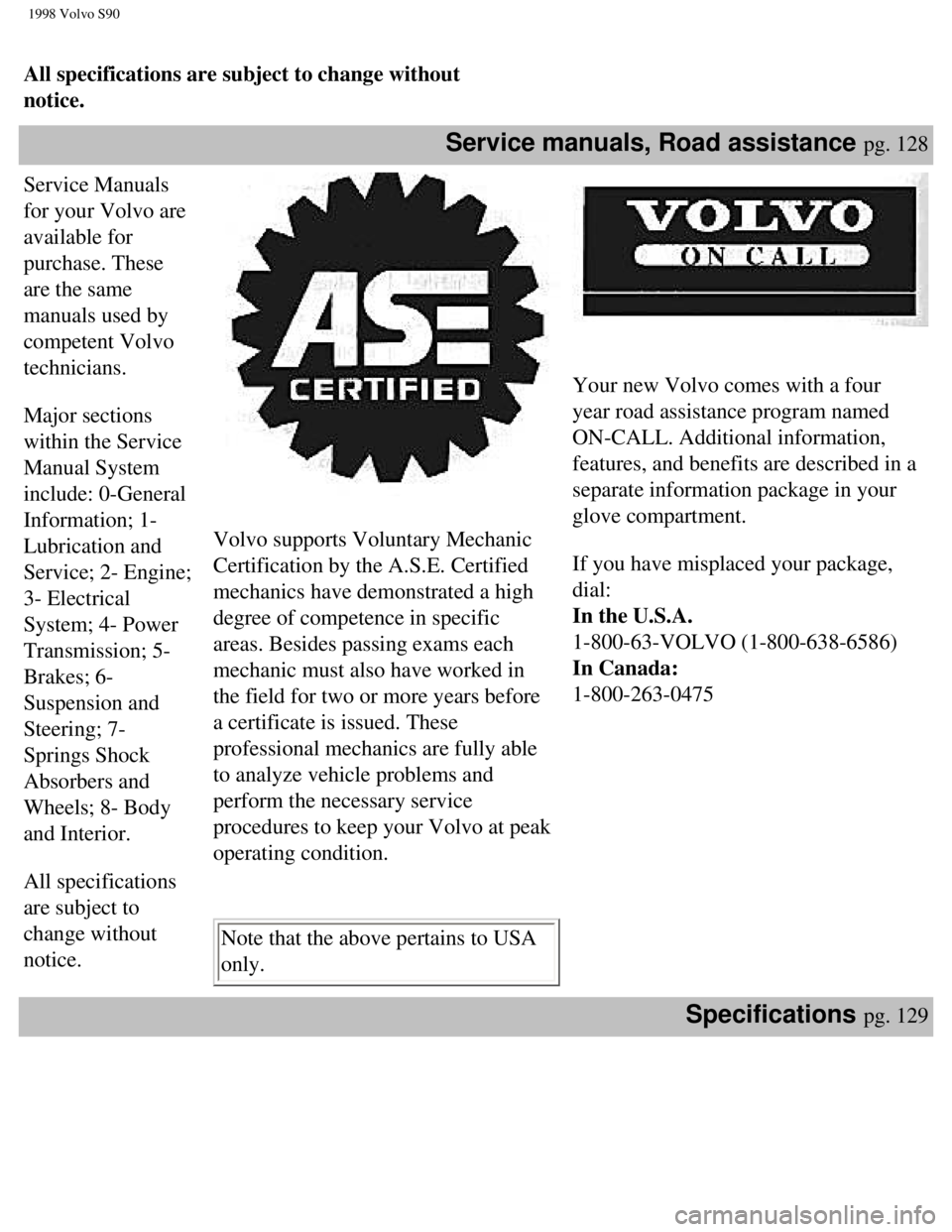
1998 Volvo S90
All specifications are subject to change without
notice.
Service manuals, Road assistance pg. 128
Service Manuals
for your Volvo are
available for
purchase. These
are the same
manuals used by
competent Volvo
technicians.
Major sections
within the Service
Manual System
include: 0-General
Information; 1-
Lubrication and
Service; 2- Engine;
3- Electrical
System; 4- Power
Transmission; 5-
Brakes; 6-
Suspension and
Steering; 7-
Springs Shock
Absorbers and
Wheels; 8- Body
and Interior.
All specifications
are subject to
change without
notice.
Volvo supports Voluntary Mechanic
Certification by the A.S.E. Certified
mechanics have demonstrated a high
degree of competence in specific
areas. Besides passing exams each
mechanic must also have worked in
the field for two or more years before
a certificate is issued. These
professional mechanics are fully able
to analyze vehicle problems and
perform the necessary service
procedures to keep your Volvo at peak
operating condition.
Note that the above pertains to USA
only.
Your new Volvo comes with a four
year road assistance program named
ON-CALL. Additional information,
features, and benefits are described in a
separate information package in your
glove compartment.
If you have misplaced your package,
dial:
In the U.S.A.
1-800-63-VOLVO (1-800-638-6586)
In Canada:
1-800-263-0475
Specifications pg. 129
file:///K|/ownersdocs/1998/1998_SV90/98S90_125.htm (5 of 7)12/30/2006 \
1:52:51 PM
Page 139 of 175
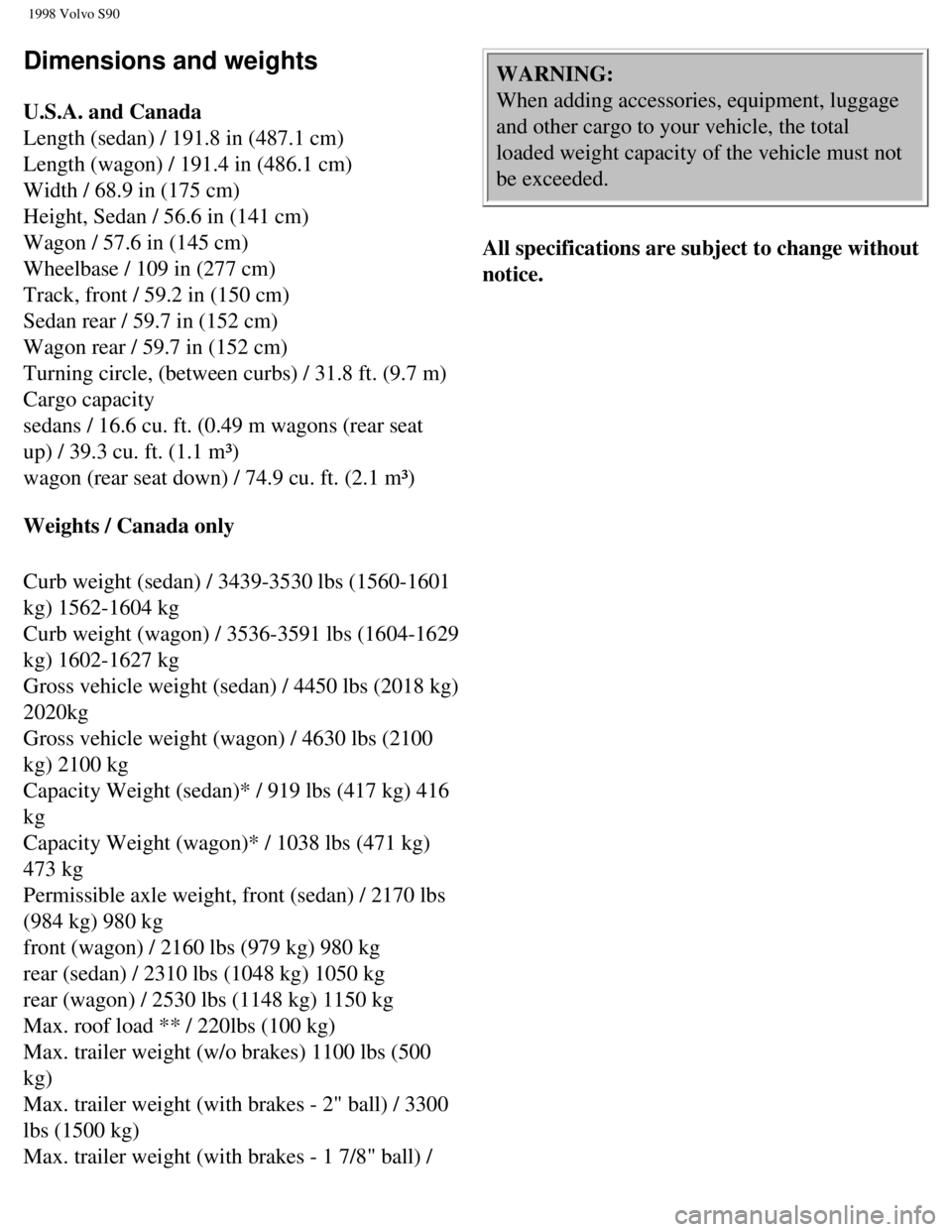
1998 Volvo S90
Dimensions and weights
U.S.A. and Canada
Length (sedan) / 191.8 in (487.1 cm)
Length (wagon) / 191.4 in (486.1 cm)
Width / 68.9 in (175 cm)
Height, Sedan / 56.6 in (141 cm)
Wagon / 57.6 in (145 cm)
Wheelbase / 109 in (277 cm)
Track, front / 59.2 in (150 cm)
Sedan rear / 59.7 in (152 cm)
Wagon rear / 59.7 in (152 cm)
Turning circle, (between curbs) / 31.8 ft. (9.7 m)
Cargo capacity
sedans / 16.6 cu. ft. (0.49 m wagons (rear seat
up) / 39.3 cu. ft. (1.1 m³)
wagon (rear seat down) / 74.9 cu. ft. (2.1 m³)
Weights / Canada only
Curb weight (sedan) / 3439-3530 lbs (1560-1601
kg) 1562-1604 kg
Curb weight (wagon) / 3536-3591 lbs (1604-1629
kg) 1602-1627 kg
Gross vehicle weight (sedan) / 4450 lbs (2018 kg)
2020kg
Gross vehicle weight (wagon) / 4630 lbs (2100
kg) 2100 kg
Capacity Weight (sedan)* / 919 lbs (417 kg) 416
kg
Capacity Weight (wagon)* / 1038 lbs (471 kg)
473 kg
Permissible axle weight, front (sedan) / 2170 lbs
(984 kg) 980 kg
front (wagon) / 2160 lbs (979 kg) 980 kg
rear (sedan) / 2310 lbs (1048 kg) 1050 kg
rear (wagon) / 2530 lbs (1148 kg) 1150 kg
Max. roof load ** / 220lbs (100 kg)
Max. trailer weight (w/o brakes) 1100 lbs (500
kg)
Max. trailer weight (with brakes - 2" ball) / 3300
lbs (1500 kg)
Max. trailer weight (with brakes - 1 7/8" ball) / WARNING:
When adding accessories, equipment, luggage
and other cargo to your vehicle, the total
loaded weight capacity of the vehicle must not
be exceeded.
All specifications are subject to change without
notice.
file:///K|/ownersdocs/1998/1998_SV90/98S90_125.htm (6 of 7)12/30/2006 \
1:52:51 PM